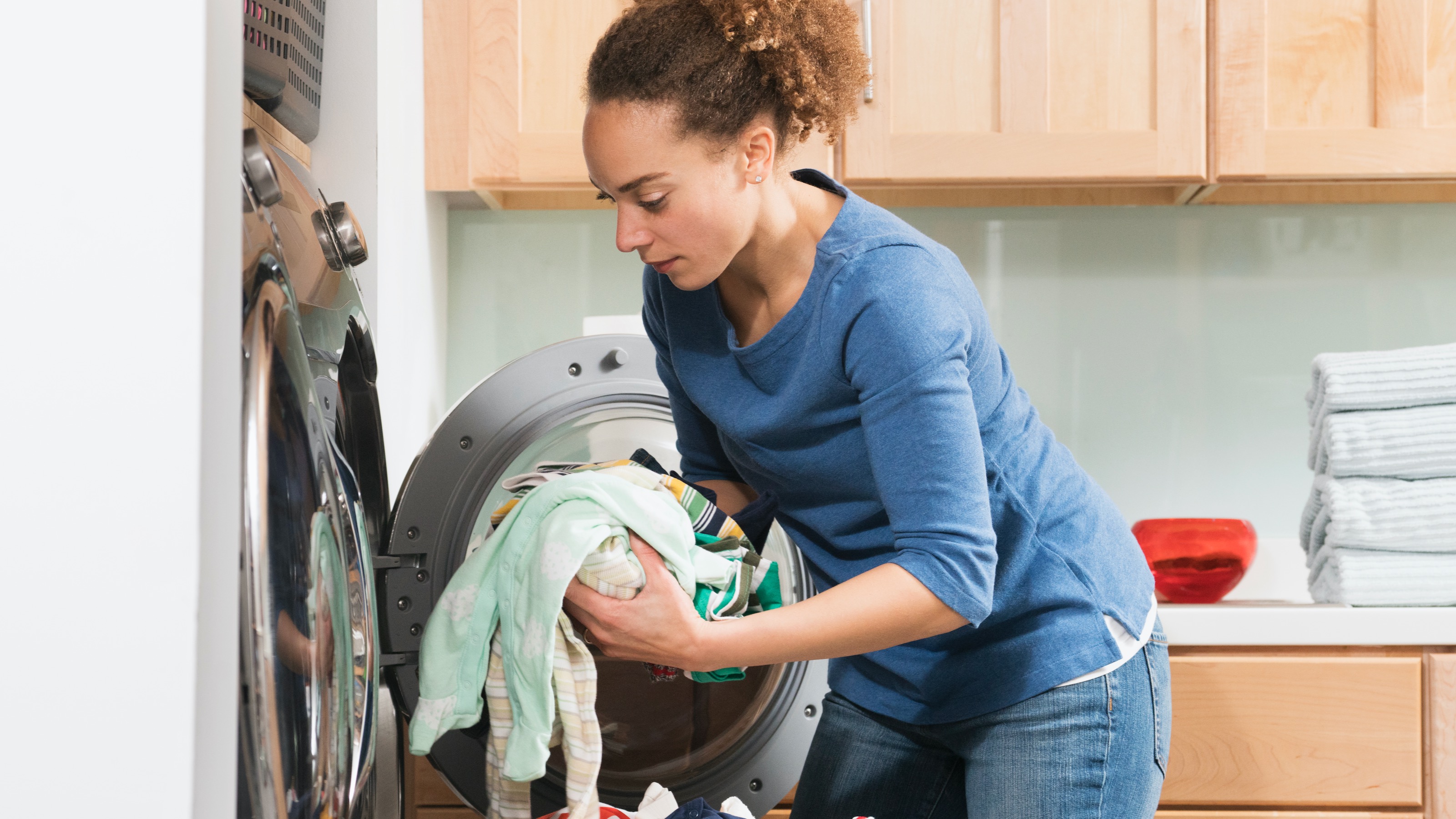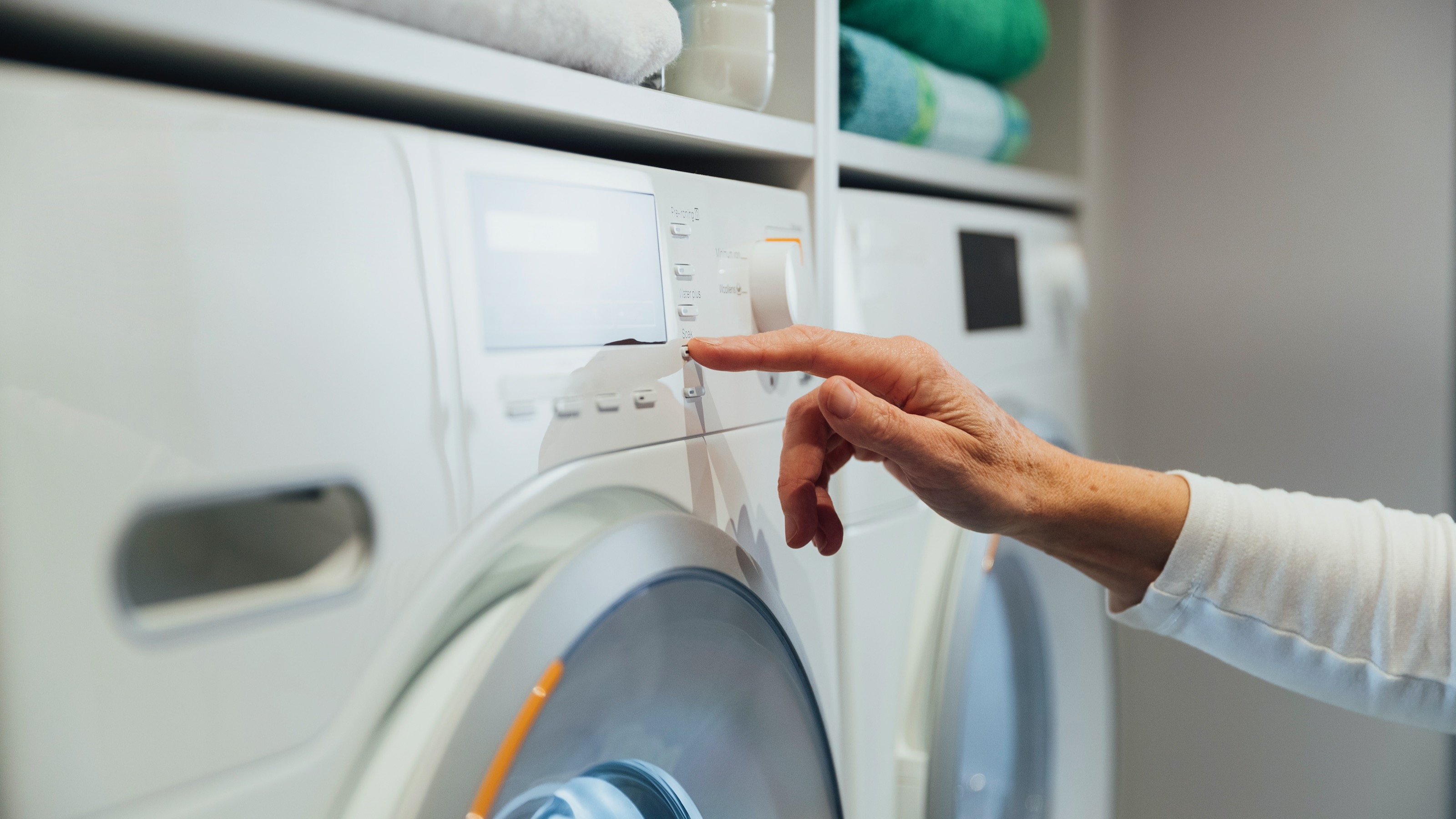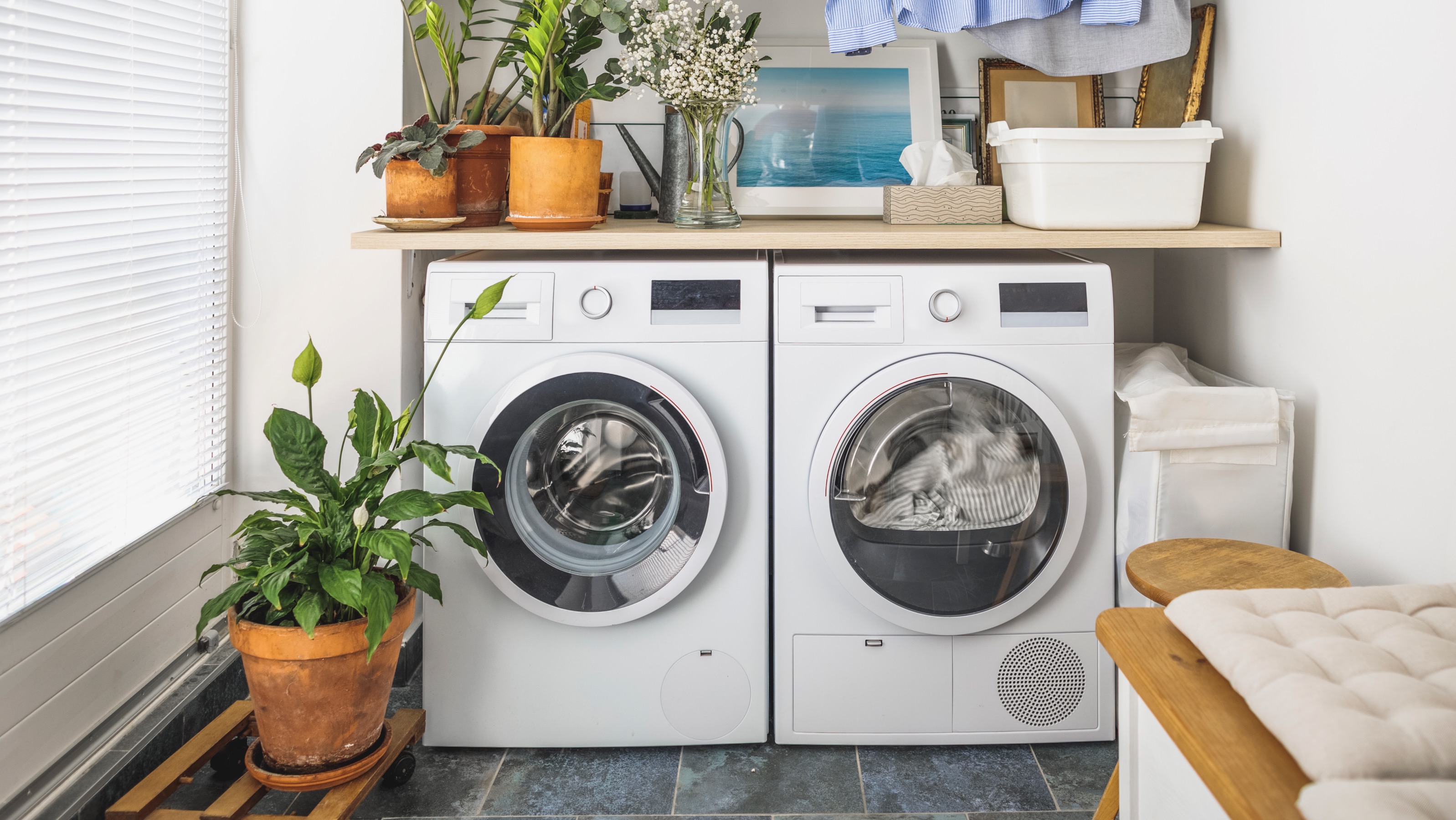How much does it cost to run a dryer?
Plus, experts explain how to save

Most of us could never be parted from our clothes dryers, but there's no denying they can guzzle up a lot of energy. That's why it's worth knowing how much your dryer costs to run and how you can cut that cost without giving up your appliance.
The best dryers are likely to be the most efficient, but an older, much less efficient machine with a higher wattage might cost double or even triple the amount to run each year. So, while there's no substitute for a dryer cycle on a rainy day and no compromise when it comes to soft and fluffy towels, it could be worth reducing your usage.
According to the Government-backed initiative Energy Star, 'about 80 percent of American homes have a clothes dryer', which is used anywhere between two and nine times a week. Below, we've listed the running costs you can expect, as well as ways to lower them.
How much does it cost to run a dryer?
In the United States, it costs, on average, $0.57 to dry a full load of laundry in a 2022 model electric dryer.
If you’re running 5.5 cycles per week (the median of the two to nine cycles estimated for most US households), you’re looking at around $163 to run the machine for the year.
These costs exclude the price of dryer sheets.
To put this figure into context, the same amount would buy:
- A year's Amazon Prime membership, and a $20 gift card.
- A Shark Navigator Deluxe vacuum cleaner
- A pair of Beats Studio noise-cancelling earbuds and a $10 iTunes voucher
- A retro Galanz espresso machine with milk frother and $30 worth of beans
We've based our average running cost calculation on one of Best Buy's most popular and best-rated dryers at the time of writing – the Samsung 7.5 Cu. Ft. Stackable Electric Dryer with Sensor Dry, $679.99. This dryer is a 5300W (watt) machine with an average 42-minute cycle time and 7.5 cu.ft. capacity.
Sign up to receive the latest news, reviews, buying guides and deals direct to your inbox
In our calculations, we used the most recent USA national average kWh electricity costs (published for July 2022). This is listed by the US Energy Information Administration (EIA) as $0.15.

How to calculate the cost of running a dryer
To calculate the cost of running a dryer, you're going to need the following information:
- The wattage of your dryer. You can usually find this in the manual, or on the serial tag printed on the machine itself. In our example, this is 5300W.
- The "cost per kWh" of your electricity. This will be listed on your most recent bill. In this example, we used the national average of 15.46 cents per kWh.
- The average time of your load. Again, you can find this in the manual, or it may be displayed on the screen when you select your cycle. In our example, this was 42 mins.
Now you will need to do the following calculations:
- Calculate the length of the load in hours. In our example, the load lasts 42 minutes. Divide 42 by 60 (minutes), and you get a load length of 0.7 hours.
- Now take your load time in hours, multiply that by the dryer's wattage, then divide by 1000. This will give you the number of kWh your appliance is using. In our example, that's (0.7 x 5300W)/1000 = 3.710kWh for every load you do.
- Finally, multiply the number of kWh your appliance uses by the cost of electricity per kWh as quoted on your bill. This will tell you how much each load is costing you. In our example, that's 3.710 x $0.1546 = $0.57 per load.
How much it costs to run a dryer in different US states
Since electricity prices can vary widely from state to state, the US Energy Information Administration (EIA) also provides regional averages of power costs. From this, we've been able to deduce how much it costs to run a dryer based on where you live in the United States.
New England, $0.85 per cycle, $283.83 per year
In the region incorporating Connecticut, Maine, Massachusetts, New Hampshire, Rhode Island, and Vermont, electricity costs $0.2298 per kWH.
Middle Atlantic, $0.69 per cycle, $198.74 per year
Average electricity costs in New Jersey, New York, Pennsylvania are $0.1873 per kWh
East North Central, $0.59 per cycle, $169.77 per year
Expect to pay $0.16 per kWh in Michigan, Illinois, Wisconsin, Indiana, and Ohio.
West North Central, $0.53 per cycle, $152.69 per year
North Dakota, South Dakota, Nebraska, Missouri, Minnesota, Kansas, and Iowa pay a rate of $0.1439 per kWh
South Atlantic, $0.52 per cycle, $149.40 per year
South Carolina, North Carolina, Virginia, West Virginia, Delaware, District of Colombia, Florida, Georgia, and Maryland pay on average $0.1408
West South Central, $0.50 per cycle, $143.14 per year
The average rate of $0.1349 covers Arkansas, Louisiana, Texas, and Oklahoma.
Mountain, $0.49 per cycle, $139.53 per year
Electricity is cheapest in the Mountain states of Arizona, Colorado, Idaho, Montana, Nevada, New Mexico, Utah, and Wyoming at $0.1315 per kWh.
Pacific Contiguous, $0.80 per cycle, $228.13 per year
California, Oregon, and Washington customers pay, on average, $0.215 per kWh for electricity.
Pacific Non Contiguous, $1.38 per cycle, $393.55 per year
Prices are highest in Alaska and Hawaii, at $0.3709 per kWh.
You may want to think about running a gas dryer vs electric dryer, particularly where electricity prices are high.
Are energy costs increasing?
The EIA reports that energy prices have been rising steadily in 2021 and 2022, including the cost of power generation fuels, especially natural gas, which helped push electricity prices higher in turn.
Severe weather events – for example, 2021's major winter storm in Texas that led to significant energy disruptions – also contribute to higher average electricity prices. Extreme cold weather – particularly common in the Central United States – can restrict the flow of natural gas for power generation and freeze wind turbines, constraining energy supply.

How to reduce the cost of running a dryer
Make your home more energy efficient with these products, switches, and hacks that will help save on the cost of running your dryer in the long term.
1. Buy an Energy Star-certified dryer
According to the US Department of Energy, "New Energy Star washers use about 25% less energy than conventional models, and Energy Star dryers use 20% less energy."
Energy Star itself claims that "If all clothes dryers sold in the U.S. were Energy Star certified, Americans could save more than $1.5 billion each year in utility costs and prevent greenhouse gas emissions equivalent to those from more than 2 million vehicles."
2. Consider where your dryer is located
"Place your dryer somewhere warm and well-ventilated,' advises Viven Fodor, laundry category manager at home appliance brand Hotpoint. "While these sound-like instructions for storing food, keep in mind that your dryer will have to work extra hard in cold and damp areas, resulting in higher energy use and higher energy bills. I’m not suggesting that you squeeze your dryer into the cereal cupboard, but we certainly wouldn't recommend placing it in a poorly insulated outhouse or garage."
3. Swap your dryer for a dehumidifier with a laundry mode
"Dehumidifiers are effective at drying washing indoors and use considerably less electricity than tumble dryers," explains Chris Michael at air conditioning specialist Meaco. "Look for dehumidifiers that have a dedicated laundry mode where the machine runs up to six hours before switching itself off to save energy."
The ultimate way to save on the cost of running a tumble dryer is to not use it at all. On a sunny day, line drying your clothes is a fine alternative. And on wet or wintery days, you could put your laundry on an airer in a room with one of our best dehumidifiers.
Dehumidifiers reduce the level of humidity by sucking in air from the room, removing the moisture, and then blowing the warm, dry air back out into the room again. This creates the perfect environment for drying laundry.
"This can help to remove the ‘damp chill’ factor in the air," explains Meaco's Chris Michael. "So your heating could run at a lower temperature or even be switched off."
A dehumidifier that can extract up to 2.6 gallons a day, with a wattage of 157w (0.157 kWh), would cost just over $0.02 an hour based on the EIA's recent kWh price average of $0.15. A dehumidifier that can extract just over 5 gallons a day, with a wattage of 480w, would use 0.48 kWh, meaning that an hour’s usage would cost $0.07. Both are a fraction of the cost of running a tumble dryer.
4. Clean the lint filter regularly
Lint is a build-up of fibers that are shed from clothes, bedding, and towels as they're tumbled. Over time, they can collect in the machine, so most dryers have a lint filter that pulls out for their easy removal.
Buying Guides
Best washer dryer combos 2025: all-in-one solutions for your laundry needs, chosen by experts
Best hair dryers: Top-rated blow dryers for all budgets
Reviews
LG DLEX8600BE 7.3 Cu. Ft. Smart Electric Dryer review: over 24 high-tech drying programs
Asko T411VDW 5.1 cu. ft. Stackable Electric Dryer review: ideal for lighter loads
Revlon Perfect Heat Fast Dry Travel Styler review
If you don't empty the lint regularly, it will make your machine less efficient and, therefore, more costly to run. Severe lint buildup could even cause a fire.
According to laundry brand Persil's website: "A blocked filter – which can happen even after just one spin if you’ve been drying fluffy items like thick towels – can mean it takes longer for the machine to dry your clothes, and it increases the risk of overheating which could damage the dryer."
Many dryers, including the Samsung model we used in our calculations, have a lint filter check indicator light on the control panel. This will remind you when it's time to clean the filter so you don't compromise the dryer's energy efficiency.
5. Avoid very hot cycles, and try 'cool down' modes
According to the US Department of Energy, very hot cycles should be avoided unless absolutely necessary. "Even if the drying cycle is longer, you’ll use less energy and be less likely to over-dry your clothes."
Some machines have smart 'cool down' cycles. These models stop actively drying your laundry sooner but rely on the residual heat in the machine to finish off the process, saving energy and money.
6. Use one drying cycle for every two loads of laundry
This is a clever way to cut down on how much you're using your dryer, but it involves planning. Aim to do two wash cycles consecutively. Once the first cycle is done, set aside what absolutely needs to go into the dryer, then hang the rest on a clothesline or on an indoor airer.
Once the second load is done, do the same and put anything essential into the dryer. Being more selective about what you dry and combining the contents of the two laundry loads will significantly reduce how often you use the dryer each month.
7. But always dry towels and heavy fabrics apart from lighter materials
While the above method can be effective at cutting down on the number of loads you do, it's still worth laundering towels and heavy cotton sheets in a load separate from lightweight fabrics. This is because the lightweight fabrics will take a lot less time to dry.
8. Add dryer balls to your load
Many swear by dryer balls as a way to keep laundry from clumping together – but did you know that this could also save energy? They're affordable, too – these bestselling Wool Dryer Balls by Handy Laundry cost $12.96 for six at Amazon.com.
"Place dryer balls into the drum and watch as they untangle your laundry, maximizing warm airflow for a quicker and more efficient cycle whilst looking after your purse strings,' says Hotpoint's Viven Fodor. "Not only that, but they help to prevent your laundry from creasing, meaning less ironing and cheaper energy bills!"
Amy Cutmore is Editor-in-Chief, Homes Audience, working across the Future Homes portfolio. She works on titles including Ideal Home, Homes & Gardens, Livingetc, Real Homes, Gardeningetc, Top Ten Reviews and Country Life. And she's a winner of the PPA's Digital Content Leader of the Year. A homes journalist for two decades, she has a strong background in technology and appliances, travelling the world in pursuit of the biggest TV screens, the smartest phones and – oh yes – the most efficient washing machines.
